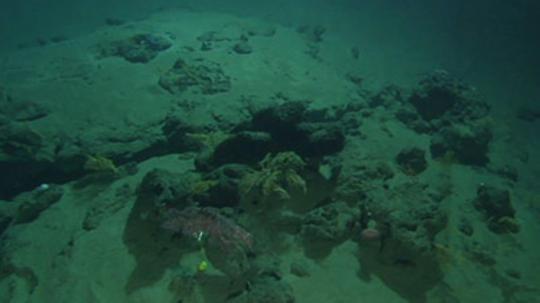This April 27, 2010 file photo shows an oil rig in the Gulf of Mexico near the Chandeleur Islands, off the Southeastern tip of Louisiana. From above, five years after the BP well explosion, the Gulf of Mexico looks clean, green and whole again, teeming with life: a testament to the resilience of nature. But there’s more than surface shimmering blue and emerald to the aftermath of the Deepwater Horizon spill. And it’s not nearly as pretty a picture, nor as clear. (AP Photo/Gerald Herbert, File)
Gulf health 5 years after BP spill: Resilient yet scarred
By SETH BORENSTEIN and CAIN BURDEAU
From above, five years after the BP well explosion, the Gulf of Mexico looks clean, green and whole again, teeming with life – a testament to the resilience of nature.
But there’s more than surface shimmering blue and emerald to the aftermath of the Deepwater Horizon spill. And it’s not as pretty a picture – nor is it as clear.
Federal data and numerous scientific studies show lingering problems. Splotches of oil still dot the seafloor and wads of tarry petroleum-smelling material hide in pockets in the marshes of Barataria Bay. Dolphin deaths have more than tripled. Nests of endangered Kemp’s Ridley sea turtles suddenly plummeted after the spill. Some fish have developed skin lesions along with oil in internal organs. Deep sea coral are hurting.
In some cases the connection to the BP spill is solid, in other cases it is harder to prove a direct causal link to the spill of millions of gallons of oil over 87 days.
“Look, we put nature on a treadmill and I think it did very very well. We should consider ourselves lucky,” said Chris Reddy of the Woods Hole Oceanographic Institute. But then he said, “It’s the things that we don’t see that have been a concern.”
To assess the health of the Gulf of Mexico, The Associated Press surveyed 26 marine scientists about two dozen aspects of the fragile ecosystem to see how this vital waterway has changed since before the April 2010 spill. On average, the researchers graded an 11 percent drop in the overall health of the Gulf of Mexico.
The surveyed scientists on average said that before the spill, the Gulf was a 73 on a 0 to 100 scale. Now it’s a 65. In the survey, scientists report the biggest drops in rating the current health of oysters, dolphins, sea turtles, marshes, and the seafloor. The AP also interviewed more than two dozen other scientists.
“The spill was – and continues to be – a disaster,” said Oregon State marine sciences professor Jane Lubchenco, who was the head of the National Oceanic and Atmospheric Administration during the spill. “The bottom line is that oil is nasty stuff. Yes, the Gulf is resilient, but it was hit pretty darn hard.”
Lubchenco said some of her worst fears about dead zones or oil spreading farther didn’t materialize. But she added: “That’s not to say there is no impact.”
BP put out a 40-page report in March, pronouncing the Gulf mostly recovered, noting that less than 2 percent of the water and seafloor sediment samples exceeded federal toxicity levels.
“Data collected thus far shows that the environmental catastrophe that so many feared, perhaps understandably at the time, did not come to pass, and the Gulf is recovering faster than expected,” BP’s senior vice president and spokesman Geoff Morrell said in an email. “This is in large part due to the Gulf’s resilience, natural processes and the effectiveness of response and clean-up efforts mounted by BP under the direction of the federal government.”
And in fact, there are experts who are surprised by how the Gulf has bounced back. Samantha Joye of the University of Georgia, who often paints a bleak picture of oil on the seafloor, recalled that in 2010 she dove in an area where the seafloor “was really hammered,” with no animals of any sort around. Then in 2014, she dove to the same place and it was quite different.
“The fact that we saw living things on the bottom made me do a happy dance,” Joye said. “The system is absolutely resilient. Thank God for that. The biggest question is: Is it going back to the same point before the spill and that’s what we don’t know.”
The federal government doesn’t think the Gulf is back. At least not yet.
“Obviously the Gulf is not as healthy as it was,” NOAA chief scientist Richard Spinrad said. He ticks off how everything about the spill and its effects were large: the “massive kill-off” of coral, the dolphin deaths, the diseased fish, and problems with oil on the seafloor.
There is no single, conclusive answer to how the Gulf of Mexico is doing, but there are many questions. Here are some of them:
WHAT HAPPENED TO DOLPHINS?
Common bottlenose dolphins have been dying at a record rate in northern parts of the Gulf of Mexico since the BP spill, according to NOAA and other scientists who have published studies on the figures. From 2002 to 2009, the Gulf averaged 63 dolphin deaths a year. That rose to 125 in the seven months after the spill in 2010 and 335 in all of 2011, averaging more than 200 a year since April 2010.
That’s the longest and largest dolphin die-off ever recorded in the Gulf. But the number of deaths has started to decline, said Stephanie Venn-Watson, a veterinary epidemiologist at the Marine Mammal Foundation and a lead author of studies on the dolphin mortality. She said there was a brief unrelated die-off in a different area of the Gulf before the spill, but afterward the dolphin deaths jumped in a way that “matched that of the timing, location and magnitude of the oil spill.”
In its report on the Gulf five years after the spill, BP said necropsies of dolphins and “other information reveal there is no evidence to conclude that the Deepwater Horizon accident had an adverse impact on bottlenose dolphin populations.”
WHAT HAPPENED TO TURTLES?
The endangered Kemp’s Ridley sea turtle used to look like a success story for biologists. It was in deep trouble and on the endangered list, but a series of actions, such as the use of turtle excluder devices, had the population soaring and it was looking like the species soon would be upgraded to merely threatened, said Selina Saville Heppell, a professor at Oregon State University.
Then, after the spill, the number of nests dropped 40 percent in one year in 2010. “We had never seen a drop that dramatic in one year before,” Heppell said. The population climbed in 2011 and 2012 but then fell again in 2013 and 2014, down to levels that haven’t been that low in nearly a decade, she said.
There is not enough data or research to blame the oil spill with scientific rigor, “but it’s a remarkable coincidence, isn’t it?” Heppell said. BP in its report said: “The changing nesting trends could be due to many factors including natural variability and record cold temperatures.”
WHAT HAPPENED TO FISH?
University of South Florida marine scientist Steve Murawski sees problems – tumors, lesions and oil traces in internal organs – in key fish such as red snapper, kingsnake eels and especially tilefish. Carcinogenic chemicals associated with oil appear to have gotten through the skin of these bottom-dwelling fish, he said.
“These bottom-feeding fish are still being impacted by the blowout,” Joye said. “Their livers have fresh Macondo oil in them. Clearly that’s a persistent impact.”
BP’s report said commercial catches for finfish “continue to exceed immediate pre-spill levels.”
WHAT HAPPENED TO BIRDS?
There have been at least two surveys of bird populations in Barataria Bay, the scene of the heaviest oiling and an important stopping place for numerous migratory bird species. Those surveys of shore birds and migratory birds found no obvious problems. But a recent study of native seaside sparrows in Barataria has found bird counts down.
BP said “analysis and field observations conducted to date indicate any impacts on bird populations and nesting were limited and were followed by a strong recovery.”
HOW ARE THE MARSHES?
Oil hit about 620 miles of Louisiana’s marshland. A lot of science has gone into studying the spill’s effects on the marsh, in particular in the Barataria Bay area. And Barataria is not a pretty picture. Tar balls and mats are routinely found here. Fishing remains closed in parts of the bay.
An entire mangrove island, an important bird colony, has nearly disappeared under the water. Satellite imagery shows that about a foot of marsh has been eaten away along many shorelines here. In the plants and animals scientists have identified oil contamination and they are tracking its progression in fish, birds, mice, dolphins and insects.
BP said by 2014, “only 0.7 miles remained heavily oiled.”
HOW ARE THE BEACHES?
After an intense focus on cleaning up the Gulf’s beaches, traces of the spill are hard to find along the sugar white sands of Florida, Alabama and Mississippi. But there are places, in particular at the extremities of south Louisiana, where large oil mats are resting, getting churned up by waves and engrained with sand deposits and the fragile delta ecosystem already stressed by sea level rise, hurricanes and a host of other man-made harms.
HOW MUCH OIL SPILLED?
The federal government used a team of scientists to calculate that about 172 million gallons spilled into the Gulf. That figure was peer-reviewed by outside scientists and confirmed by independent researchers, but BP put the number much lower, closer to 100 million gallons.
A federal judge in January essentially split the difference and ruled that almost 134 million gallons went into the Gulf.
WHERE DID THE OIL GO?
“It’s not all gone,” said former U.S. Geological Survey chief Marcia McNutt. Her team calculated that most of the oil evaporated, dissolved or dispersed. Two peer-reviewed studies by separate respected teams in 2014 and 2015 found that up to 10 million gallons of oil is left on the seafloor; one of them compared it to a bathtub ring. BP disputed those figures.
“I saw it; I’ve got video of it,” University of Georgia’s Joye said. It’s not liquid or a layer, she said, but splotches like the spatter from a paintball gun.
WHAT DON’T WE KNOW?
NOAA chief scientist Spinrad said the government hopes to finish its five-year assessment on the health of the Gulf by the end of the year, so it is too early to make any real conclusions. Some problems may show up later. It was not until 10 years after 1989’s Exxon Valdez spill that scientists noticed a dramatic crash in the vital herring population.
___
Borenstein reported from Washington, Burdeau from New Orleans. Reporter Stacey Plaisance contributed from New Orleans.
[livemarket market_name="KONK Life LiveMarket" limit=3 category=“” show_signup=0 show_more=0]






No Comment